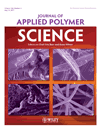Thermoplastic corn starch reinforced with cotton cellulose nanofibers
Abstract
This work evaluates the use of cotton cellulose nanofibers (CCN) as a reinforcing agent to prepare thermoplastic corn starch (TPS) matrix plasticized with 30 wt % of glycerol. The nanocomposites were filled with 0.5–5.0 wt % of CCN on a dry-starch basis. The dried nanofibers were resuspended through the use of an ultrasonicator and then introduced in the fixed water formulation for obtaining TPS. The nanocomposites were compounded in a corotating twin-screw extruder. Scanning transmission electron microscopy (STEM), field emission gun (FEG), X-ray diffraction (XRD) and thermogravimetric analysis (TGA), in air atmosphere, were used to characterize nanofibers, neat TPS, and nanocomposites. The results showed that the nanofibers had needlelike structure with an average length of about 135 ± 50 nm and an average diameter of about 14 ± 4 nm. The addition of CCN was effective to enhance the mechanical properties of neat TPS in compositions above 2.5 wt %, although some agglomeration could be observed. The resulting nanocomposites showed good structural stability, because the amylopectin transcrystallization phenomena on the surface of nanofibers had not occurred. Only a slight decrease in the crystallinity index and a minor increase in the water absorption in relation to neat TPS were observed. An increase in the thermal stability of TPS nanocomposites with respect to neat TPS was verified, but it was independent of the CCN content. © 2010 Wiley Periodicals, Inc. J Appl Polym Sci, 2011




